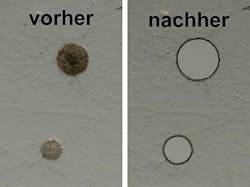Laser microdissection, sequencing method combine to analyze whole genome
By combining laser microdissection and next-generation sequencing (NGS), researchers at the Ruhr University Bochum (RUB) Department of General and Molecular Botany (Bochum, Germany) have analyzed gene activity in the whole genome of small, multicellular fungi in one pass.
In multicellular organisms, each cell contains the same genetic material; however, often only a fraction of the genes are expressed. These differences in gene expression are the cause of variations in the structure and physiology of cells. Gene expression is therefore the key to understanding the development of multicellular organisms.
"In large organisms such as plants, it is usually not a problem to get enough starting material to study gene expression," explains Dr. Minou Nowrousian. "In the case of microorganisms, organs often consist of only a few cells, and might be embedded in other tissues from which they are difficult to separate." Therefore, biologists of the research groups of Prof. Dr. Ulrich Kück and Minou Nowrousian combined laser microdissection with NGS to analyze gene activity during the development of certain sexual structures of fungi that measure 0.5 mm.
In laser microdissection, scientists cut defined regions of a sample under the light microscope with a laser beam. Doing so enabled the researchers to collect the fruiting bodies of the fungus Sordaria macrospora, which has been used for decades as a model organism in developmental biology. From the fruiting bodies, they isolated the RNAâwhich represents the gene activity. And with NGS, they characterized the activity of all genes of the genome simultaneously.
The RUB researchers compared the wild-type fungus with a mutant form that has no mature fruiting bodies (unable to reproduce sexually). For this purpose, they studied gene expression in young, immature fruiting bodies. They showed that some fruiting body-specific genes are not activated in the mutant. The defective gene contains the âbuilding instructionsâ for a so-called transcription factorâa protein that turns other genes on or off. The researchers also found that the fruiting body has a completely different genetic activity pattern to non-reproductive tissue.
Fungi have a big impact on virtually all ecosystems. They make significant contributions to the reduction of animal and vegetable waste products and thereby contribute to the global carbon cycle. Some species live in symbiosis with plants or animals, while other species are pathogens. In the chemical and pharmaceutical industry, fungi are used for the production of antibiotics and enzymes. The formation of pathogenic or symbiotic interactions and the production of medicines or biotechnology-related substances are often tied to specific stages in the life cycle of a fungus. The analysis of the development is therefore crucial not only for basic research, but also for industrial applications.
-----
Follow us on Twitter, 'like' us on Facebook, and join our group on LinkedIn
Laser Focus World has gone mobile: Get all of the mobile-friendly options here.
Subscribe now to BioOptics World magazine; it's free!

